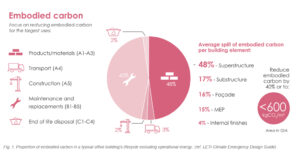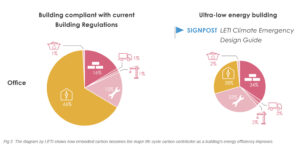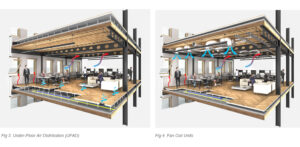Waterman’s sustainability experts have delved into building services’ strategies and how these can dramatically reduce the lifecycle embodied carbon of a commercial office development.
Buildings need to be designed to be flexible and adaptable for generations to come rather than becoming obsolete and demolished once they can no longer perform their function.
The operational energy use of our buildings is progressively reducing as we design them to become more energy efficient. But this is far from the full picture.
The lifecycle of MEP services and the choice of system for an office building have a significant impact on its overall embodied carbon. LETI highlights that MEP services represent around 15% of the embodied carbon in a new office development, see Fig 1.

Fig. 1. Proportion of embodied carbon in a typical office building’s lifecycle excluding operational energy. (ref. LETI Climate Emergency Design Guide)
However, these components have an economic lifespan ranging from 15 to 25 years and this means the real impact on the building’s carbon footprint becomes much greater. LETI predicts that ongoing maintenance and replacement account for 45% of whole life embodied carbon and a significant proportion of this is related to MEP systems.
LETI also highlights that as buildings become more energy efficient and operational energy reduces, the embodied carbon from construction, maintenance and replacement account for two-thirds of the building’s lifecycle carbon, see Fig 2.
Fig 2. The diagram by LETI shows how embodied carbon becomes the major life cycle carbon contributor as a building’s energy efficiency improves.
Old building stock not future proof
A large proportion of 1960s and 70s commercial buildings have been demolished as they were not adaptable enough to be rejuvenated. These buildings were not designed for the future. They failed to accommodate modern working cultures and expectations.
With today’s focus on sustainability and reduction in whole life carbon, buildings are now being designed with longevity in mind. However, we still find ourselves in a situation where the MEP systems are replaced at least two or three times over the normal life of an office building.
The replacement of MEP systems is not just a question of lifespan. The continual retrofits and the churn of tenants in a building generally means substantial alterations, not only in the initial Cat B fit-out, but through the cycle of occupation. But it doesn’t stop there because at the end of occupation when leases expire, these spaces are altered again by being reverted to open plan.
The continued drive for ‘fully-repairing leases’ means it is not uncommon for MEP systems, particularly heating and cooling, to be replaced far in advance of their economic lifespan.
Flexibility – future occupier demands
The length of lease cycles is reducing along with an increased demand from businesses for their workplaces to be scalable, which puts even more emphasis on the need for adaptability to avoid future carbon penalties. Knight Frank discusses this very issue in detail in their London Report 2019 – ‘A Design For Life’.
How can we reduce building services’ embodied whole-life carbon against the tide of shorter leases and changes in workplace cultures?
Our sustainability experts have carried out studies to develop strategies that will assist developers in working towards net-zero carbon in their future developments. The focus has been to review which choice of air-conditioning systems has the least long-term carbon impact over a building’s life cycle.
The study led by Mark Terndrup, Director of Building Services, analysed the embodied carbon associated with the initial installation of different types of air-conditioning system and then added the embodied carbon associated with typical fit-outs, maintenance, repair and ultimately replacement.
Mark says: “It is evident that Under-Floor Air Distribution (UFAD) systems are one answer to the challenge of energy efficient cooling whilst avoiding extensive whole-life carbon penalties. They have the least initial quantum of components installed and are far more favourable in carbon terms. UFAD means fewer physical components in the office space in comparison to alternatives like Fan Coil Units (FCU’s) and Chilled Beams.”
The UFAD solution, uses an all-air based cooling strategy without ductwork or terminal units in the office space cutting out the embodied carbon normally incurred through terminal units such as fan coil units or chilled beams. Instead the raised floor is used as a supply plenum with simple manually adjustable swirl diffusers set in the floor tiles. This simple strategy means that adaptation for cellularization is quick and simple while maintenance is minimal, with no need for replacement of parts. Alterations are generally limited to moving swirl diffusers and lights / detectors. This significantly reduces equipment replacement over the building’s lifecycle and maximises the opportunity for a net-zero carbon construction.
With a conventional solution such as Fan Coil Units, Fig 4., as much as 30-50% of the system ends up being removed or altered by tenants as part of the initial fit-out. This percentage increases significantly over the operational life of the building. The multitude of components need replacement every 12 – 15 years.
Range of benefits
UFAD systems require enhanced façade performance to limit solar gain in order to operate successfully. If designed correctly this can achieve free cooling for up to 85% of the year, reducing the overall operational energy. This is a major benefit for tenants and will be an asset to buildings of the future, particularly as UFAD works in harmony with mixed mode natural ventilation.
We asked Mark if UFAD fits all types of buildings. He said: “The UFAD solution can even work in tall buildings, a floor-by-floor air handling plant strategy can be adopted using up to 100% fresh air for free cooling. This solution minimises the central plant to free up space for amenity use at both roof and basement.”
“This is also beneficial for dealing with tenant churn. The floor by floor solution allows you to manage staggered leasing with minimal disruption, because each floor can easily be adapted to suit tenants as they come and go, or when their requirements change. This reduces life cycle embodied carbon too!”
UFAD systems are compatible with timber and concrete or steel solutions and can work with floor to floor heights of 3.85m. The clean soffits are free of terminal units which gives an uncluttered, contemporary feel with tall airy spaces full of light.
There is also a multitude of wellness benefits. The UFAD delivers more consistent thermal control and gives each occupant individual temperature control over their immediate area. The lower ventilation fan speed significantly reduces noise pollution and creates an overall quieter and more stress-free environment. The supply of air at floor level provides 20% better ventilation in comparison to a ceiling-based HVAC system. The naturally rising air moves suspended particles upwards and away from occupants, resulting in a superior indoor air quality. Whilst it is too early to talk about specifics yet, Mark is certain that we will have a renewed focus on our future designs post-COVID-19, not least from an air quality point of view.
Less is more
So perhaps the obvious question is: “Why isn’t UFAD used more prevalently?”. The answer is multifaceted but stems predominantly from the market perception that a solution so simple must be inferior – it doesn’t come with “bells and whistles”.
Historically, UFAD systems have only failed because they were not designed correctly or misunderstood so not appropriately adapted during fit-out. The failures were predominantly due to the lack of solar gain control at the façade or inadequate provisions to manage the perimeter heat gain. This has led to some general mistrust in UFAD. However, there is a plethora of buildings where UFAD has been implemented successfully, such as the south east building of the Nomura HQ, 1 Angel Lane, and the White Building in Notting Dale Village.
The ability for our buildings to respond to tenants needs without repeatedly making carbon intensive alterations is essential as we strive towards a zero-carbon future. The simplicity of the UFAD system, with its minimum amount of components, makes it easily adaptable to changes in the workplace.
Configured on a floor by floor system basis, additional benefits can be realised for landlords and building owners through the ability to respond to tenant churn with minimum disruption to other occupiers.
When coupled with a low-energy building envelope, which is rapidly becoming the norm, the full potential for free cooling is realised, driving down the operational carbon.
UFAD isn’t the ‘be all and end all’ but it goes a long way to transforming the carbon footprint of our buildings. Cooled slabs and other passive cooling systems yield similar benefits. Simplicity is key to unlocking the challenge of delivering low carbon strategies for our buildings, so we must convince the market that ‘Less’ is indeed more!





